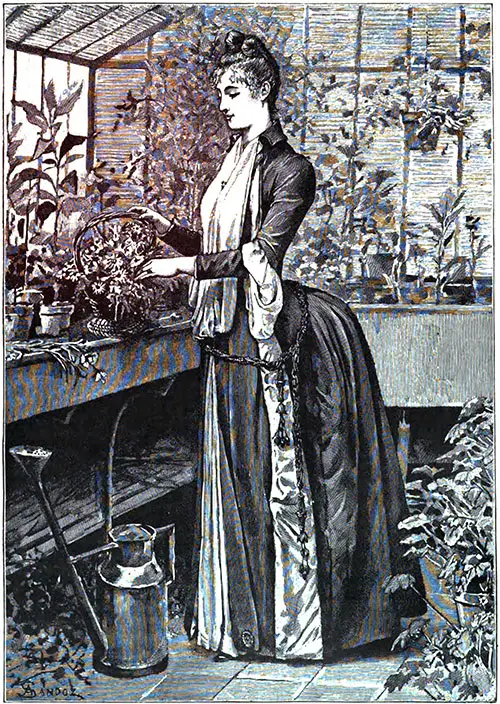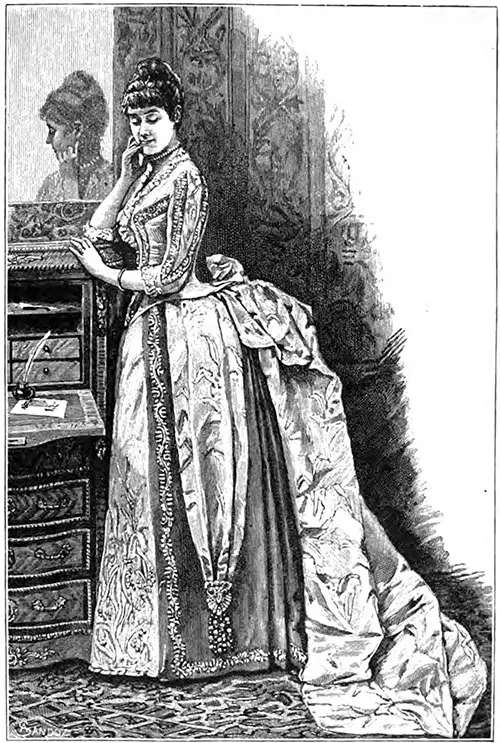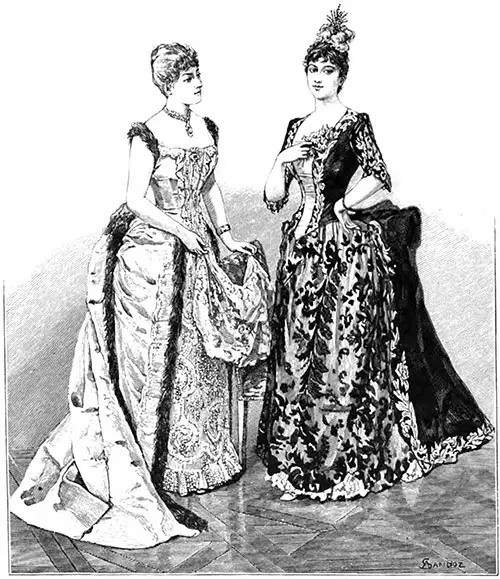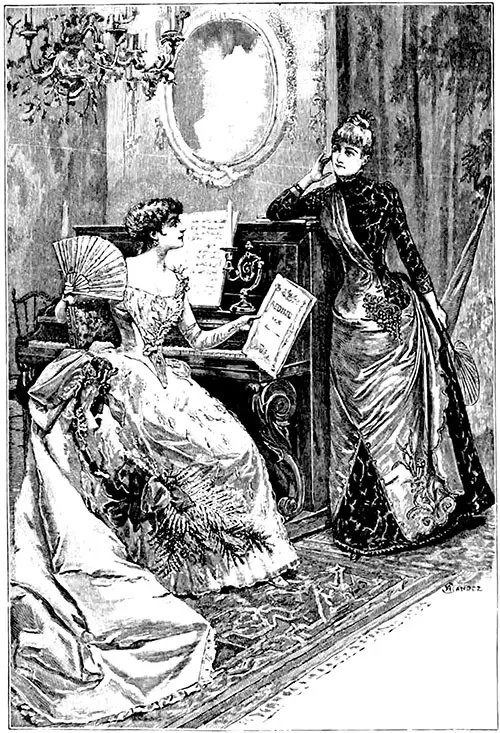Paris Fashions December 1887
Greek, Directoire, and Imperial fashions are likely to be in high favor this winter. There is evidently at present a great tendency towards straight gowns with elongated panels, together with long Sappho robes clinging closely to the figure and enveloping it in their soft and graceful folds.

Sarah Bernhardt Tea Gown
For quiet morning and walking costumes, in cloth, the formal tailor cut still obtains, but Parisian élégantes, objecting to this rather too plain style, smarten it now and then with a broad contrasting band, which usually encircles the hem of the skirt and corresponds with the jaunty waistcoat.
Thus, a red band will warm up a black or green material, whilst a figured galon in a subdued tone of yellow would glow on otter-colored cloth.
Pinked-out cloths, too, are still in vogue, and the leading dressmakers impart to these prettily cut-out stuffs a special cachet and originality by skillfully blending, in the “building" up of the costumes, various shades and tints, which managed by inartistic hands would often offer startling combinations.
To wit: a scarlet waistcoat enlivening a vest of green cloth, rather showily adorned with broad gold froggings, or a front of admiral blue velvet added to a jacket of willow-green tweed.
In better and certainly safer taste is a skirt of grey cloth, surrounded with pinked-out flounces, and partly concealed at the back by a long drapery; in front a short apron is ingeniously serrated to recall a large rose-leaf.
The basque of the Directoire bodice is also vandyked and allows a glimpse of the bright lining in red-brick harmonizing with the lone; cuffs and revers of red cloth.
Elastic or jersey cloths are more than ever in requisition, especially since they are dyed in all the fashionable dark and light colors and are used for the fancy bodices now most popular.
These are either lavishly braided, beaded, or plainly trimmed with a row of gilt buttons, or with galons embroidered with dainty camaieu silk and glittering tinsel threads. Such trim and glove-fitting bodices are worn out of doors with a Louis XVI vest also ornamented with embroidery.

For evening wear the choice of material is simply unlimited and magnificent; it includes every kind of material from splendid lampas to cloud-like tulle, and with this immense variety at their disposal, clever dress makers create marvelous and elaborate costumes, which not only defy the pen of the chronicler, but even the brush of the painter.
Truly most of the gowns are a perfect maze of folds, waves, scarves, draperies, so cunningly contrived that it is impossible to detect how they are put together; and to such an extent is this complication carried, that the dressmaker herself can seldom reproduce two dresses exactly alike.
Lovely flowing tea-gowns are made with brocaded satin sparingly striped with wide watered silk ribbon and opening on a princess front of Pompadour gauze.
Still more sumptuous ones are in velvet wrought with gold, and deftly draped in front, from the throat to the feet, with either China crape or Indian gauze, the whole intermingled with cascades of old lace.
The well-known Mme. Morin-Blossier has just forwarded to the young Duchess of "M" a handsome dinner-gown in pearl-grey satin, brocaded with large lilies of the valley, self-toned, but yet so skillfully woven as to imitate nature to perfection.
It displays elbow sleeves and front in silk gauze, tastefully barred with lace insertions, and dotted with butterfly bows in shrimp pink glace silk, like the broad sash negligently knotted at the side.
Another successful costume from the same firm consists of a Louis XVI casaque, with a princess front, and mounted with gathers at the back of the bodice, appropriately made in delicate cream peau de soie powdered with blooming Rose de Sevres chrysanthemums.
A fluffy marabout trimming daintily peeps from under the edge of the skirt, whilst a Swiss belt in pink velvet, fastened in front with antique Dresden buttons, confines to the waist the artistic folds of a Greek tunic in Indian gauze, exquisitely embroidered.
A velvet bracelet terminates, at the elbow, the sleeves in the transparent fabric. A striking example of the truly graceful style is found on the stage of the Théâtre Français in a piece of Auguste Vacquerie, entitled Souvent Homme varie.

In this comedy the charming actress, Mile. Pierson dons a cuirass bodice in resplendent cloth of gold, with a rather scanty skirt in ringdove-colored damask, over which a scarf of brick-red satin is loosely knotted.
A Turkish cap and a satchel, in velvet wrought with gold, give the last Eastern touch to this unique costume.
It may not be too late yet to say a few words about the superb trousseau of Mile. Alice Rothschild, now Mrs. Sassoon; descriptions of wonderfully rich outfits, gowns, and presents are always pleasing to chronicle.
Foremost, of course, is the bridal robe, a masterpiece of Worth's, composed of white satin, with a long train and flounces of old point d’Angleterre, looped up here and there with sprays of orange-blossoms; garlands of the virginal bloom described paniers at the sides.
A visiting-dress in golden-brown poult de soie had a Watteau casaque falling quite straight over a short habit-bodice in velvet ciselé, powdered with coffee-berries. On the sides huge pockets sparkled with a rich silk gimp, beaded with mordoré jet.
Brighter-looking apparently was the reception costume, in embossed copper faille, set off with a draped front in cream silk gauze beautifully wrought with solid and open work, which was well displayed by a lining of turquoise-blue satin merveilleux.
At the side floated the ends of a wide sash in blue satin, corresponding with the bows studded all over the bodice.

Evening Dress And Visiting Costume
The Redingote Barras must not be omitted, belonging as it does to one of the leading types of the season.
This stylish coat in pale lilac peau de soie, checked with tiny wreaths in heliotrope satin, had its fronts turned back to show off the skirt in lilac sicilienne, surrounded from the waist to the hem with a close succession of scalloped flounces, whilst bows of heliotrope velvet slightly raised the skit on the sides.
Antique buttons, set with brilliants, flashed on the velvet corselet as well as on the sleeves, trimmed with velvet ribbon and an elegant gauze drapery.
The fichu, in embroidered gauze, was coquettishly arranged around the shoulders in small flat and tapering folds, with the ends knotted on the chest to fall as a jabot down to the waist.
Fickle Dame Fashion has certainly not forgotten young ladies' evening gowns; they are, above all, remarkable for their simplicity, with their skirt cut slightly longer than formerly, just enough to touch the ground.
One specimen in kilted China crape is striped with white watered ribbon, which is crossed with narrow gold galon; on one side droops a vaporous puffed scarf, which is carried at the back to disappear under the small pouf, thus leaving the opposite side entirely plain.
Bows of the striped gold moire ribbon appear on the low bodice, gracefully draped and knotted on the shoulders and at the waist with these smart bows.
The most youthful and exquisite dresses are, however, still contrived with plain, tinseled, or striped net arranged in the ballet style, with several skirts of the diaphanous fabric thrown over a foundation of satin, which softly shimmers through the open meshes of the tulle.
The bodice à la Vierge is very suitable for these airy costumes; it is frequently ornamented with tufts of some glowing flowers, which also are arranged to trail along the skirt; or, again, a shower of detached petals is thrown over the snowy skirt, as if fallen by accident.
The most appropriate cloak for the cold season is evidently the long and well-wrapping pelisse, either in some rich stuff, such as sealskin, watered plush, raised velvet, or in cloth lined with fur.
The smaller visite-mantle, with straight sleeves, is more suitable to accompany dressy costumes, which it displays to advantage, instead of hiding and crushing them as the redingotes and pelisses are sure to do.
The same bewildering selection of shapes, materials, and trimmings is noticeable in millinery, as well as in dressmaking. However, no better guide can be given in this perplexing question than a short report of a visit to the Maison Virot.
Quite unique is a Cardinal hat in red molleton, with its soft dented crown and flat brim lined and toned down with black velvet. In front, there is a cluster of shaded ostrich-tips intermingled with stiff "ears," deftly fashioned with black watered ribbon.
A similar model reproduced in white felt and trimmed with bronze-colored feathers and ribbon, would be very stylish for a drive or a matinee. The Lancret hat, in vert-de-gris velvet, has a high crown bordered with a wide brim raised high on one side; a torsade of light-colored watered silk encircles the crown, and is knotted in front amongst a panache of feathers gently drooping at the back; black velvet with a twist in pink moire silk, and black feathers, is another adaptation of this style.
The Fragonard hat has also a soft crown in velvet of the peculiar shot tint known as "fly's wings," adorned in front with a group of bronze ribbon loops, simulating an aigrette, which towers over a military plume, and at the side is placed a high stiff wing, quaintly finished off with a square end.
Very ladylike is the Infanta bonnet in black velvet, studded with small gilt flies, the gathered crown edged with a fluting of black lace over gold lace; on the side a fancy aigrette, composed of gold lace loops and black ostrich-tips.
The coiffure of our élégantes, like their dresses, is gradually getting longer and narrower. Noirat, the hairdresser of the day, who last year introduced, or at least revived, for full dress the accroche-coeurs à la Duchesse de Bourgogne, has brought out a slight addition to the "Diana" knot; three or four long curls, attached at the side of the smooth bandeau, gracefully fall down the nape of the neck and the back.
The plain twist still, however, remains the favorite for morning and ordinary wear.
Enough of the always alluring subject of chiffons. Let us turn a furtive glance to a highly artistic publication, which is sure to be one of the most welcome Christmas presents.
This new book so temptingly entitled "Les Peintres de la Femme," is published by the Maison Dentu, and bears the signature of Claude Vento, but another pseudonym of the well-known nom de plume of Violet, the reporter par excellence of the fashionable world.
Biographies of painters, such as Henner, Bonnat, Chaplin, Lefebvre, Carolus Duran, Cabanel, and of the sculptor Prosper d'Epinay, will be given in this splendid work, where, in short, will appear numerous notes on a galaxy of living French artists who have acquired any celebrity for their poetical rendering or interpretation of female beauty.
Those famous masters themselves have consented to illustrate "Les Peintres de la Femme," which will contain over fifty engravings, mostly reproductions of chefs-d'oeuvre.
Johnstone, Violette, “December Fashions: Paris,” in The Woman’s World, Cassell & Company, Limited, London, Paris, New York & Melbourne, Volume I, No. 2, December 1887, p.90-94.
Note: We have edited this text to correct grammatical errors and improve word choice to clarify the article for today’s readers. Changes made are typically minor, and we often left passive text “as is.” Those who need to quote the article directly should verify any changes by reviewing the original material.
